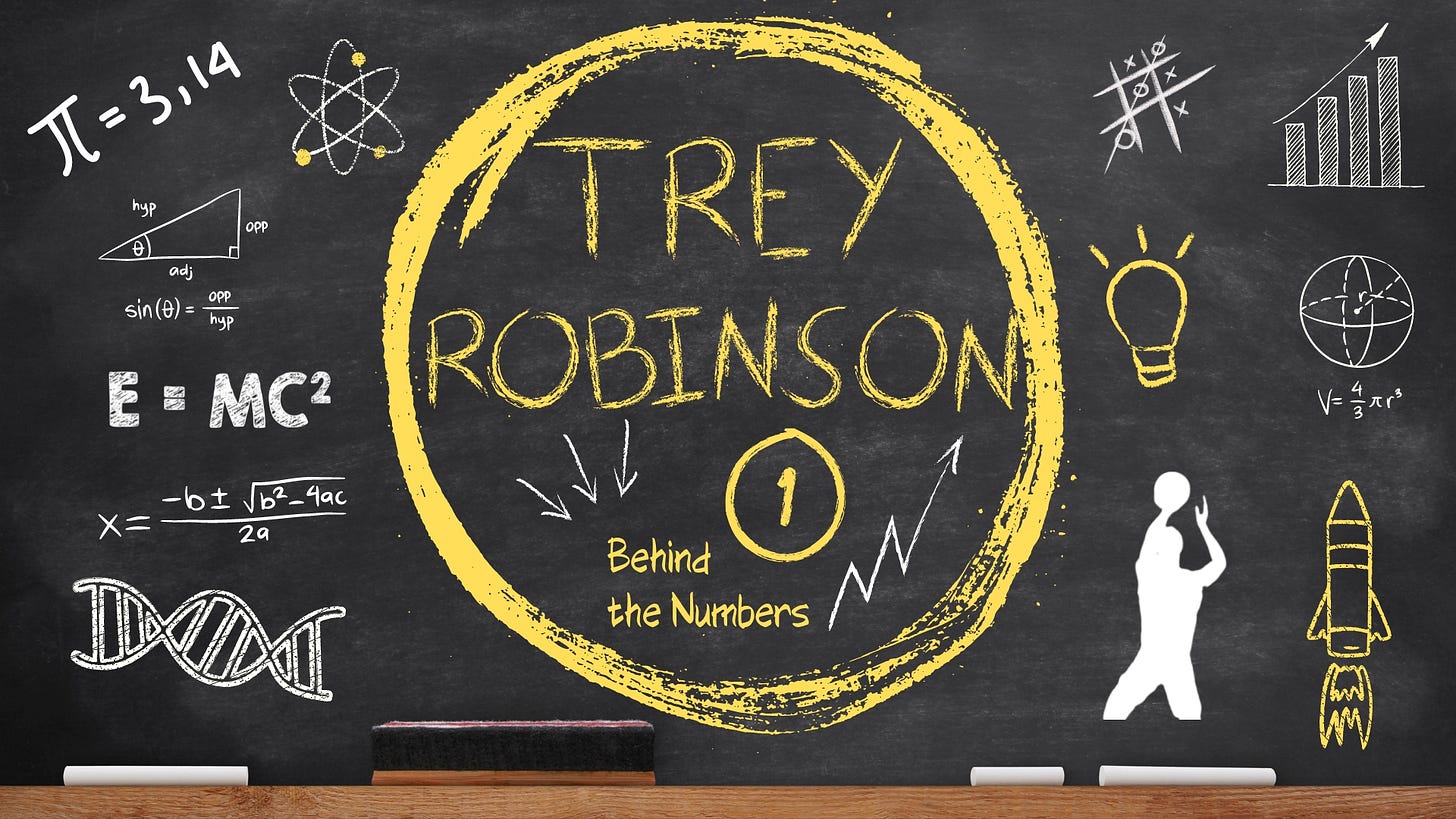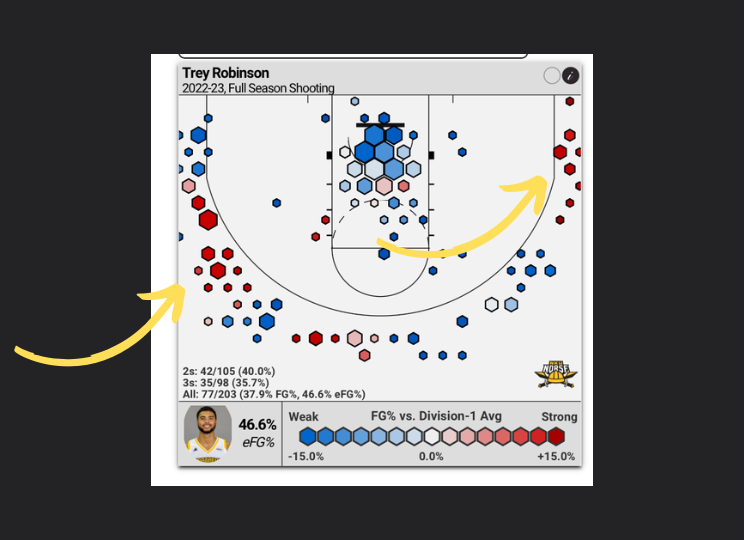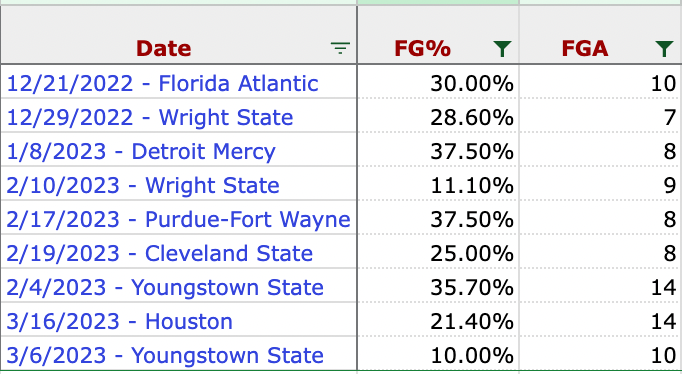Trey Robinson has been on Norse Report’s radar since before he committed. On our old site, we had a full scouting breakdown of him, including his high school stats and various highlight clips. When he committed in the fall of 2019, one of the writers who used to write with us went out to watch him play and wrote a stellar piece highlighting his skill set and abilities. If you search “@NorseReport Trey” on Twitter, you are sure to see nothing but hype for the kid. We love Trey. But for some reason, many in the fan base and surrounding media have somewhat forgotten about Trey. And to the extent that this isn’t the case, he certainly does not get the amount of coverage that other players have. Marques Warrick is the Kentucky kid. Lexington raised, Kentucky claimed. Then you have Sam Vinson, the local hero that brought a state championship to the city of Fort Thomas in Northern Kentucky. Though Trey grew up and went to school little more than a half an hour from campus, he is not usually given the same level of attention as the other two. Maybe it’s because he’s from across the Ohio Ocean, maybe it’s because the other two have put up ungodly stats their first 2-3 seasons. To basketball fans, specifically NBA basketball fans — we know the third player in any “big 3” typically gets the least amount of the attention and honor as the other two. In Boston you had Paul Pierce & Kevin Garnett… and Ray Allen. In Miami you had Wade & LeBron… and Bosh. In Cleveland you had Kyrie and LeBron… and Kevin Love. But what’s true of all 3 of those players: Ray Allen, Chris Bosh and Kevin Love? They are all FIRST Ballot Hall of Famers. It’s time to put a proportionate amount of respect on Trey’s name.
The son of Jamie and Stephen, basketball was in Trey’s blood. Trey’s parents both played college basketball, his mom set records in high school that still stand to this day! He grew up in Hamilton, OH — a mere 43 miles from NKU’s campus where he attended the high school named after his city. An amazing high school career brought college scouts and among them were the boys from NKU.
What is it that has made Trey so important to the roster? Well for starters, his shooting has improved tremendously. Seriously, if I blindly showed you the stats side-by-side and asked you which two different players they were from — you would never think to question that they were from the same person. In addition to his shooting, which can vary for any shooter, regardless of their skill-level, Trey brings energy every single time he is on the court. Trey plays the game with an edge, almost as if a large part of what he is doing out there is motivated by an insatiable need to prove us all wrong. Almost as if basketball is a part of his genetic makeup. Let’s dive in.
Improved Shooting
Trey clearly has been working in the gym. Go listen to any good shooter talk about what it takes to become ‘lights out’. A few of these guys are accessible via Twitter — go Tweet at Cole Murray or Tyler Sharpe. Go hit up Drew McDonald, who wasn’t a worldclass shooter (still very good) when he first got here, but he developed throughout him time in college. While their answers may vary, what they will tell you will almost certainly include one word or theme: repetition. See, shooting is all about muscle memory. Depth perception. You do not need to be a great athlete to shoot well. You can be 125 pounds or 350 pounds and shoot well. Good shooters can be 5’3” or 7’3”. The only way to become dominant at it is to PUT IN THE WORK. Get your muscles so used to shooting from certain distances that it becomes something you can do in your sleep. It’s clear to me when looking at the numbers that two things are happening with Trey and his shooting numbers:
He’s getting great looks — a product of being in tune with the offense AND his teammates
He’s practiced a LOT — impossible to see a jump in shooting like he has without putting in some serious gym time.
CAREER HIGHS
Currently Trey is shooting 34% from 3 and 76% from the FT line, both career highs for him. After seeing a slight dip in both stats during his second year, he made gigantic leaps in Year 3. If he continues this trend, he could easily push 38-40% from 3 and +80% from the FT line next year.
SHOT CHARTS TELL ALL
If you really want to track Trey’s shooting improvement, you’ve got to take a look at his shot chart data, year over year. Don’t want to look it up? Don’t know where to look? We’ve got you covered. Take a look at this (you may have to scroll a bit) and we’ll meet you at the bottom of the graphic to talk about what this all means.
So that’s a lot of random red and blue dots, but we can help parse through what it means. Trey scores in a couple of main ways within our offense: slashing and shooting. When looking at the frequency of his attempts, represented by the size of the dots, his shots this season were heavily concentrated either within 5-7 feet of the basket, or from 3. Statistically, across all NCAA players on average, the most effective shots are open layups & dunks followed by wide open 3s. When assessing the points per shot data, the least effective shot is a contested turnaround jumper/hook around the rim. That’s just data. It’s not to say that great players don’t deviate outside of the trends, but the majority of players fit squarely into those general rules. For Trey, he saw MASSIVE improvement in 2 spots specifically this season: left side throw line extended 3 pointer, right corner 3 pointer. The frequency in which Trey was trusted to shoot more of these shots was met with resounding results: Trey was given more opportunities, AND HE DELIVERED.
The two spots where Trey saw the most success were, as mentioned above, the right corner and the free throw line extended area on the left side. Trey shot a total of 8 threes this season from the right corner, sinking 5 of them. I know that doesn’t sound like a ton of attempts, it’s a modest amount for a humble yet talented shooter. Let’s try this on for size… from the left free throw line extended, Trey was a total of 10 for 19 from this spot.
Everyone Has An Off Night
Even the best players in the world have an off night. I’m a big NBA fan. Perhaps even bigger of an NBA fan than college basketball, which is surprising I’m sure considering all of the work that I’ve put in over the years covering a relatively small school like NKU. Even in the NBA, the greatest collection of 450 players in the entire world, there are guys that just do not have it on certain nights. What sets those guys apart, and what keeps them in the NBA — is what else are they doing on those “off nights” that is helping the team win?
The same thing is true of players at the college level — and probably more so with the advent of the transfer portal. One thing that I previously wrote about (I believe going back to Trey’s freshman year) was the noticeable dip in playing time Trey saw that season as the year went on. By no means did I think Trey wasn’t out there giving his all, or even worthy of the care and guidance of the coaches — I just saw what many others saw. He didn’t seem quite ready to be THAT GUY every single night every single second as a true freshman at the college level. Guess what — very few are. He was in good company. Fortunately for all of us, the coaching staff saw the very same thing and they never gave up on Trey. And Trey, being the young man that he is, never gave up on himself. This has really shown this year in a big way. Allow me to explain…
ANALYZING THE GAME LOGS
Obviously one of the most noticeable improvements in Trey’s game, which we’ve exhausted above was the rise in his overall shooting efficiency. But as every hooper knows — off nights happen. Many times when a player is shooting poorly, they just are too much of a liability to be out on the court, but not always. What keeps players on the court during those “off nights” is how they allow it to impact the rest of their game, if at all. To make this assessment for I compiled all of Trey’s game logs from last season and filtered the data based on 2 factors. The first was “shot attempts”, and the second was “field goal percentage”. I wanted to create a a customized stat “split”, “Off shooting nights” vs. the mean. I wanted to asses just how long of a leash Trey is given, and why.
These were the 9 games that met the criteria that the date provided to us. So what did he DO in these games? When the chips were down, when he wasn’t shooting well, how did he let that impact him? Did he mail it in and become a detriment to his team? Or did he rise to the occasion and find other ways to produce?
MO’ MISSES, MO’ MINUTES
This season, Trey averaged over 22.2 minutes per game but there were a few games this year where he registered under 8 minutes. For “minutes per game” it’s fine to use averages, but when assessing trends in the data, I tend to use median because it gives you a better idea of the frequency of something happening. In other words, while Trey averaged 22.2 minutes per game, his median for minutes per game was 25.5, basically indicating that in the majority of his game played he registered a higher number of minutes than his average. (Those early exit games pulled down the average by a lot). Now, with that said, Trey’s AVERAGE minutes played in those games was 27.4 (+5.2 his season average) and the median minutes played for Trey was 29 (+3.5 his average).
Wait that doesn’t make sense. Let me deviate for a second and speak directly to Darrin Horn. UH HELLO. DARRIN, @ darrin_horn are you READING THIS?? Sir. You are giving MORE MINUTES to a player when he misses MORE OF HIS SHOTS? What are we doing!?
THAT WAS AN OVERREACTION
Ohhhhhh. I see it now. Sorry guys. I scrolled a little bit, looked at the game log data a little harder, and it makes sense now. Let’s keep going, I think I can explain this effectively.
MY MANS RUNS ON ROCKET FUEL
So throughout the season you can see that Trey bring a lot to the game in terms of the effort, energy and aggression he plays with. While these are great attributes to have (you need guys who play like that) they are intangibles that are impossible to quantify. For our purposes, we have some of the counting stats that serve as “effort stats” in a sense. Guys, EVERY SINGLE ONE of Trey’s “effort stats” ticked upwards during his off shooting nights. Seriously, all of them.
REBOUNDS
SEASON AVERAGE: 3.7
Off Shooting Night: 4.2
OFFENSIVE REBOUNDS
SEASON AVERAGE: 1.3
Off Shooting Night: 1.9
STEALS
SEASON AVERAGE: 1.0
Off Shooting Night: 1.2
To me, this demonstrates a pretty obvious trend. Trey Robinson — the guy who at one point in his freshman year was literally BENCHED because he was getting too much in his own head when he was having an off game, just two years later has found a way to turn those off games into motivation, JET FUEL so to speak in order to BLAST OFF in the effort category. Like Doc Rivers said above, all he wants is effort. Give him everything you have and you will play, because they need you. 90% of coaches in America will tell you that they agree with this. And clearly Darrin Horn feels the same. So what’s the answer to the question, then? Why does Trey play so much when he’s shooting poorly? Why does this coaching staff fawn over him every chance they get. Why is he constantly finding himself on the court in the critical moments of the game? Why are the 8 games where he logged 28 minutes or more 8 of the most important games we played this season? It’s a simple answer, really.
Before anyone gets made at me, I have 25 years of experience playing, coaching and being a fan of basketball and baseball. Those are my niche. It’s not that I don’t like soccer, volleyball, tennis, etc. I just don’t know the games enough to analyze data on them. Softball is going to be hard enough for me, but it’s closer to baseball at least so I know it’s doable.











